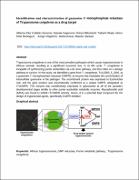| dc.description.abstract | Trypanosoma congolense is one of the most prevalent pathogens which causes trypanosomosis in African animals, resulting in a significant economic loss. In its life cycle, T. congolense is incapable of synthesizing purine nucleotides via a de novo pathway, and thus relies on a salvage pathway to survive. In this study, we identified a gene from T. congolense, TcIL3000_5_1940, as a guanosine 5′-monophosphate reductase (GMPR), an enzyme that modulates the concentration of intracellular guanosine in the pathogen. The recombinant protein was expressed in Escherichia coli, and the gene product was enzymatically confirmed as a unique GMPR, designated as rTcGMPR. This enzyme was constitutively expressed in glycosomes at all of the parasite's developmental stages similar to other purine nucleotide metabolic enzymes. Mycophenolic acid (MPA) was found to inhibit rTcGMPR activity. Hence, it is a potential lead compound for the design of trypanocidal agents, specifically GMPR inhibitor. | en_US |


